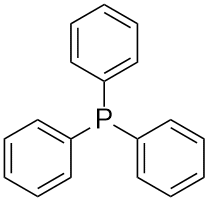Triphenylphosphine is widely utilized in research focused on:
- Synthesis of Organophosphorus Compounds: It serves as a key reagent in the synthesis of various organophosphorus compounds, which are important in agrochemicals and pharmaceuticals.
- Catalysis: This compound acts as a catalyst in numerous organic reactions, enhancing reaction rates and improving yields, making it invaluable in chemical manufacturing.
- Ligand in Coordination Chemistry: Triphenylphosphine is commonly used as a ligand in coordination chemistry, facilitating the formation of metal complexes that are essential in catalysis and materials science.
- Pharmaceutical Development: It plays a significant role in drug synthesis, particularly in the development of antitumor agents and other therapeutic compounds, contributing to advancements in medicine.
- Organic Photovoltaics: The compound is utilized in the fabrication of organic solar cells, improving their efficiency and stability, which is crucial for the renewable energy sector.
General Information
Properties
Safety and Regulations
Applications
Triphenylphosphine is widely utilized in research focused on:
- Synthesis of Organophosphorus Compounds: It serves as a key reagent in the synthesis of various organophosphorus compounds, which are important in agrochemicals and pharmaceuticals.
- Catalysis: This compound acts as a catalyst in numerous organic reactions, enhancing reaction rates and improving yields, making it invaluable in chemical manufacturing.
- Ligand in Coordination Chemistry: Triphenylphosphine is commonly used as a ligand in coordination chemistry, facilitating the formation of metal complexes that are essential in catalysis and materials science.
- Pharmaceutical Development: It plays a significant role in drug synthesis, particularly in the development of antitumor agents and other therapeutic compounds, contributing to advancements in medicine.
- Organic Photovoltaics: The compound is utilized in the fabrication of organic solar cells, improving their efficiency and stability, which is crucial for the renewable energy sector.
Documents
Safety Data Sheets (SDS)
The SDS provides comprehensive safety information on handling, storage, and disposal of the product.
Product Specification (PS)
The PS provides a comprehensive breakdown of the product’s properties, including chemical composition, physical state, purity, and storage requirements. It also details acceptable quality ranges and the product's intended applications.
Certificates of Analysis (COA)
Search for Certificates of Analysis (COA) by entering the products Lot Number. Lot and Batch Numbers can be found on a product’s label following the words ‘Lot’ or ‘Batch’.
*Catalog Number
*Lot Number
Certificates Of Origin (COO)
This COO confirms the country where the product was manufactured, and also details the materials and components used in it and whether it is derived from natural, synthetic, or other specific sources. This certificate may be required for customs, trade, and regulatory compliance.
*Catalog Number
*Lot Number
Safety Data Sheets (SDS)
The SDS provides comprehensive safety information on handling, storage, and disposal of the product.
DownloadProduct Specification (PS)
The PS provides a comprehensive breakdown of the product’s properties, including chemical composition, physical state, purity, and storage requirements. It also details acceptable quality ranges and the product's intended applications.
DownloadCertificates of Analysis (COA)
Search for Certificates of Analysis (COA) by entering the products Lot Number. Lot and Batch Numbers can be found on a product’s label following the words ‘Lot’ or ‘Batch’.
*Catalog Number
*Lot Number
Certificates Of Origin (COO)
This COO confirms the country where the product was manufactured, and also details the materials and components used in it and whether it is derived from natural, synthetic, or other specific sources. This certificate may be required for customs, trade, and regulatory compliance.


